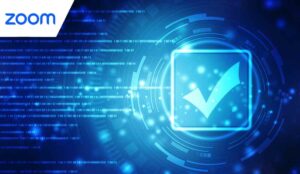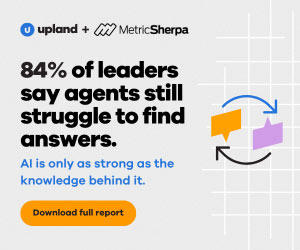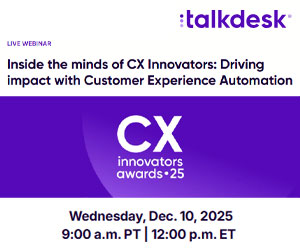Brian Mistretta at NICE explains how government contact centres can adapt to federal cost cutting.
Huge increases in call volume caused by the pandemic stretched some agencies’ resources to the breaking point and left many citizens frustrated and without timely access to essential benefits.
At the same time, government call centres were (and still are) grappling with the rapid transition to a remote agent model to ensure continuity of service and the safety of their employees.
These massive disruptions occurred while many agencies’ contact centres were transforming their service philosophy away from simple cost containment and towards providing superior customer service experiences for their constituents.
And then there’s federal cost cutting.
Government agencies are always vulnerable to budget cuts, but on top of everything else contact centres are dealing with right now, cost-cutting measures could be the straw that breaks the camel’s back.
On the surface, budget cuts can appear to be in direct conflict with improving customer experience (CX) and supporting remote agents. After all, most major improvement initiatives require significant incremental, ongoing funding.
But if a government contact centre uses a strategic approach to how they use their funds in the short term, it can squeeze out significant operational costs and future-proof against subsequent cost-cutting measures. Additionally, this can be done while also improving the customer and agent experience.
This article will review how government contact centres can seamlessly adapt to federal funding cuts by streamlining interactions and processes.
4 Ways to Absorb Budget Cuts That Can Also Improve Employee and Customer Experience
When contact centres are required to do more with less, they need to take meaningful measures to reduce costs. While agent wages are by far a contact centre’s largest cost category, tightening the belt doesn’t need to mean laying off employees.
Streamlining operations and being smarter with how you use labor dollars can do the job, and both are possible with the right contact centre technology.
Let’s take a look at some ways government call centres can operate leaner while also satisfying citizens and agents.
1. Cloud-Based Platform to Orchestrate Seamless Personal and Self-Guided Journeys
What Is It?
A cloud-based platform is what industry-leading contact centres use to streamline operations and provide exceptional CX.
With a cloud-based platform, also known as software as a service (SaaS), the software vendor hosts the applications and end-users access them through an internet or private network connection. SaaS customers essentially outsource hardware and software support and data management and security to their software provider.
Modern cloud contact centre solutions include standard operational capabilities such as workforce management, call and screen recording, automatic contact distributors (ACDs), and interactive voice response (IVR) systems, but because many of these applications are infused with artificial intelligence, they produce more accurate results.
Additionally, the best cloud contact centre platforms provide CX-enhancing capabilities such as omnichannel and digital self-service.
How Does This Solution Save Money?
There are three primary areas where a cloud platform can help government agencies reduce costs.
IT Overhead and Software Licenses.
When an organization moves from on-premises technology to the cloud, much of the IT overhead associated with supporting the old system is eliminated. The agency no longer needs to purchase and manage servers, apply software updates, tune databases, or safeguard data.
Additionally, there are no software licenses to purchase. Organizations pay a monthly fee based on what they actually use, which is typically a more cost-effective pricing model.
Omnichannel Capabilities Can Reduce Average Handle Time (AHT).
Omnichannel experiences allow customers to move seamlessly across channels without the need to repeat themselves.
For example, if a customer begins their support journey by sending an email to customer service and then calls a couple of days later to follow up, he won’t need to repeat the information contained in the email because the phone agent has access to it. The elimination of repetition streamlines the interaction and reduces AHT.
Self-Service is Much Cheaper Than Agent Assistance.
Gartner estimates that the average cost of an agent-assisted contact is $8.01, while an average self-service transaction only costs 10 cents. Let’s do some quick math.
If your contact centre handles 500,000 agent-assisted interactions per year and you’re able switch 8% (40,000) to self-service, you would save over $316,000. The savings can really add up!
How do Customers Benefit?
Omnichannel experiences are more satisfying because they eliminate the need for customers to repeat themselves (a big CX pet peeve). Our research revealed that 96% of consumers expect organizations to make it easy to switch channels without the need to repeat information.
Additionally, most people prefer to solve their own simple problems through self-service, and self-service gives citizens 24/7 access to support.
How do Agents Benefit?
Agents don’t like asking people to repeat information either! Omnichannel capabilities make agents more successful by providing them with the context and customer information they need to quickly resolve issues.
And when the contact centre uses effective self-service, the nature of agent-assisted interactions becomes less mundane and more interesting.
2. Unified Agent Desktop With Knowledge Management Solution to Keep Citizen and Office Information in One Easy-To-Find Location
What Is It?
All too often, agents have to toggle through multiple, disparate applications to enter data and find information. This can be especially onerous if an agency uses old, legacy systems.
A unified agent desktop consolidates all the systems an agent uses into a single user interface, which creates efficiencies by enabling a single sign-on and eliminating the need to toggle.
And when one of the consolidated applications is a smart knowledge base, agents have ready access to pertinent information. The best knowledge management systems can even “listen” to conversations and automatically retrieve relevant content for the agent.
How Does This Solution Save Money?
A unified agent desktop puts everything an agent needs at their fingertips, which creates the potential to substantially decrease AHT. Reducing AHT increases agent capacity and enables each agent to handle more interactions—essentially “doing more with less.”
Additionally, having access to a smart knowledge base can improve first contact resolution rates and eliminate costly and inefficient follow up contacts.
How do Customers Benefit?
Today’s customers value speed, so lower handle times can improve the customer service experience. Additionally, the right agent tools can increase accuracy of resolutions and eliminate the requirement for customers to call back, both of which are CX wins.
How do Agents Benefit?
Using more efficient and better designed technology would improve any employee’s satisfaction level, but this is especially true of government contact centre agents who are on the front lines of helping citizens.
Modern contact centre software makes agents more successful at meeting performance goals and eliminates the hassle of signing into and toggling through multiple applications while trying to assist customers.
3. Reduced Training Costs Through Personalized and Effective Training
What Is It?
Have you ever been forced to attend training that didn’t pertain to you or which was about a topic you were already proficient in?
This happens to customer service agents far too often. “Average handle time is increasing so we need everyone to attend refresher training.” Even those agents performing at or better than goal.
A shotgun approach won’t yield the benefits government contact centres want. Instead, they should do personalized, targeted training. Tools such as interaction analytics and quality management analytics leverage artificial intelligence to pinpoint topics and agents that need improvement.
These insights allow government call centres to be more efficient by training the right agents on the right topics.
How Does This Solution Save Money?
As mentioned earlier, labor is a contact centre’s largest cost category. Pulling every agent into training that may not be relevant to them isn’t an effective use of training funds. Targeted, micro learning is more cost efficient and can yield better outcomes.
How do Customers Benefit?
Service levels won’t suffer unnecessarily if everyone isn’t pulled off queues to attend formal training. Additionally, when targeted training is effective, customers will be served by more qualified agents.
This means they will receive faster, more accurate resolutions delivered by agents with strong technical and soft skills.
How do Agents Benefit?
Sitting through irrelevant training sessions can be a morale buster that doesn’t make agents any more effective at their jobs. Conversely, employees value effective professional development and it can improve engagement and loyalty.
As an example, Gallup found that, “59% of millennials say opportunities to learn and grow are extremely important to them when applying for a job.” A personalized training plan can deliver the professional and skill growth employees value.
4. Real-Time Integrated Guidance to Reduce AHT and Improve CX
What Is It?
Real-time integrated guidance refers to AI-infused capabilities that provide intelligent, in the moment guidance to agents about areas such as soft skills and next best steps.
This type of real-time feedback can help agents better control interactions, come to resolutions more quickly, and improve customer satisfaction.
Real-time interaction guidance software is an example of a tool that can improve the quality of interactions as they are taking place.
This solution listens to phone conversations in real time and determines both agent and customer sentiment. It then prompts agents about relevant soft skills such as empathy and active listening.
How Does This Solution Save Money?
These real-time integrated guidance tools are designed to help agents gain faster closure and improve CX. Solutions that suggest next steps and automatically retrieve knowledge content can reduce handle times, especially for new agents who are still learning the ropes.
Additionally, helping agents improve call control through effective use of soft skills can also decrease AHT. These qualities also help decrease future volume by increasing first contact resolutions.
How do Customers Benefit?
Customers want fast, competent service delivered by a knowledgeable and friendly agent. These real-time guidance solutions can help government contact centres meet all these expectations.
How do Agents Benefit?
In the moment guidance provides agents with additional support, which is especially important for remote workers. Additionally, it helps agents develop skills, satisfy customers, and meet individual performance goals.
Federal cost cutting doesn’t have to be the death of customer satisfaction and lead to employee furloughs. The right contact centre technology can help government contact centres adapt to and even thrive with smaller budgets.
This blog post has been re-published by kind permission of NiCE-ltd – View the Original Article
For more information about NiCE-ltd - visit the NiCE-ltd Website
Call Centre Helper is not responsible for the content of these guest blog posts. The opinions expressed in this article are those of the author, and do not necessarily reflect those of Call Centre Helper.
Author: NiCE-ltd
Published On: 22nd Sep 2022 - Last modified: 23rd Apr 2024
Read more about - Guest Blogs, Brian Mistretta, NiCE, NiCE CXone






 NiCE (NASDAQ: NICE) is transforming the world with AI that puts people first. Our purpose-built AI-powered platforms automate engagements into proactive, safe, intelligent actions, empowering individuals and organizations to innovate and act, from interaction to resolution. Trusted by organizations throughout 150+ countries worldwide, NiCE’s platforms are widely adopted across industries connecting people, systems, and workflows to work smarter at scale, elevating performance across the organization, delivering proven measurable outcomes.
NiCE (NASDAQ: NICE) is transforming the world with AI that puts people first. Our purpose-built AI-powered platforms automate engagements into proactive, safe, intelligent actions, empowering individuals and organizations to innovate and act, from interaction to resolution. Trusted by organizations throughout 150+ countries worldwide, NiCE’s platforms are widely adopted across industries connecting people, systems, and workflows to work smarter at scale, elevating performance across the organization, delivering proven measurable outcomes. 































